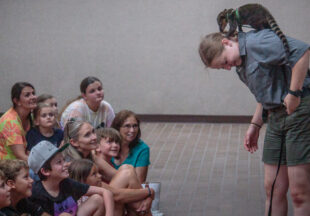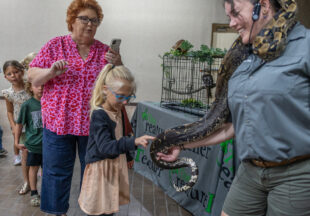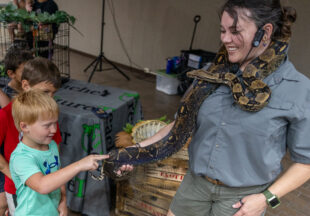BISD unveils extensive security measures for new school year

With the new school year in full swing in Breckenridge, many new safety procedures, equipment, programs and training are in place. At the Board of Trustees meeting on Monday, Aug 13, Breckenridge Independent School District Superintendent Tim Seymore highlighted some of the changes that were made over the summer to make the local campuses safer.
New Surveillance cameras in place
One of the biggest changes was the addition of a new surveillance camera system at all five campuses. Seymore said the cameras are inconspicuous and can have at least two weeks of video data stored on them. During the meeting, Seymore showed an example of how the cameras in the high school cafeteria work, demonstrating the capabilities the cameras have for viewing the room from different angles.
He said the cameras are flexible and the systems can be modified to be used however the district chooses. The principals have monitors for the cameras on their computers; they can have two computer monitors in their office – one for viewing the camera feeds and one for their regular work activities such as checking email.
Stay Alert anonymous text and email alert system
The superintendent also discussed the Stay Alert system, an anonymous text, call and email alert system that is available 24 hours a day, seven days a week.
Seymore said the district has had the system in place for about three years, but people haven’t really been using it. He said they are planning an awareness campaign to let people know more about it.
The system can be used for anything from reporting bullying to reporting the names of who broke into one of the school buildings. Seymore said the system collects the information from the tip and it gets sent to the superintendent. If he’s not available, the information goes down a list of other approved contacts. If nobody responds, he said, it ends up at the police department, all in a matter of about two minutes.
“Last year we had one or two. It kind of amazes me that people don’t use it,” Seymore said. “I know we talked about it; we have the signs up, posters up. We have a whole page dedicated to it on our website where it is. It’s a cool thing, and I wish we would use it the way it’s intended, to get information. And I hope we can get better information from it. Thankfully, we don’t have tons of horrible things going on and we don’t need lots of information. But I’d like for people to use it when they know stuff we should know.”
Civilian Response to Active Shooter Training
Before school started this year, teachers and staff received Civilian Response to Active Shooter Training provided by Stephens County Sheriff Will Holt and Chief Deputy Kevin Roach. The training is based on the platform that Holt and Roach are certified to teach.
Seymore said they conducted the training by campus because they tweaked it for the age of the students at each campus. South Elementary and Breckenridge Junior High School were scheduled to receive the training together.
The training follows the “avoid, deny, defend” strategy. Seymore said the training is based on first trying to avoid the danger and get out the situation.
“Our premise for all these years is, anytime anything happens, lock down in your classroom, hunker down,” he said. “Well that’s not a great plan with active shooters. Everybody who can run should run and get out of the way. Then, if that can’t happen, you deny access, barricade the door; you block yourself in; you deny them access to you as best you can. And the last thing you do is defend yourself. If it’s inevitable, then you have to confront them, to defend yourself.”
Seymore said he didn’t want to go into too much detail during last Monday’s meeting because he didn’t want to give away too much of their strategy on defending against such attacks because he didn’t want a potential shooter to be able to prepare against them in an attack.
Elementary School Door controls
Another big security and safety addition this year is the electronic door controls at the elementary schools. To gain entry to the buildings, a visitor has to ring the buzzer at the front door, which is monitored by a video camera.
“It’s been very well received,” Seymore said. “I’ve probably got more feedback from that than almost anything I’ve done since I’ve been here. Most people like that.”
In the past, when somebody came to the door and rang the buzzer to be let in, the secretary in the office had to come to the door and see who they were and then let them in. Now, the secretary is able to see from the office on the video camera who is at the door and whether to buzz them in or not.
Cop-Sync-911 – Instant Alert System
Another security system that Seymore said will be put into place soon is the CopSync911 – Instant Alert System. The system allows teachers to instantly and silently summon the five closest police officers to their school in an emergency situation. During the meeting, Seymore presented a video on the program that showed how the Sweetwater School District was tied to the Sweetwater Police Department through CopSync911.
According to the video, when a Sweetwater teacher sends an alert, it instantly appears on the computer screen of the five closest sheriff or police cars and engages the officers in a chat room. Instant messages from the officers responding to the alert let the 911 dispatcher know they are responding to the alert and are on their way to the school. That allows officers to go ahead and respond to the call while the dispatcher provides them with additional information.
Through the system, information can be exchanged between the law enforcement department, the officers and the school in real time.
Also according to the video, officers can use the system to see maps of the school while the teachers inside provide them with real-time updates about the exact, present location and nature of the danger.
With one click on a teacher’s computer screen, officers can be on their way within seconds, even if no further information is received from the teacher.
Seymore said in addition to the system being on the teachers’ computers, teachers and administrators will also be able to put an app on their phones.
“It will work even if a coach is 100 miles out of town and they have a wreck in a school bus. He said it will read the GPS off their phone and send an alert to the nearest officers who have CopSync and to the nearest 911 dispatch office, even if there are no officers nearby on CopSync.
Seymore said when the system is installed on the school district’s computers, it will also be installed on the computer systems for the local law enforcement agencies in Breckenridge.
Mental Health First Aid Training
Another program BISD will continue to provide is mental health first aid training. The training teaches people how to recognize students, or anyone else, who has mental health issues and what they can do to help them.
Seymore said he believes a large part of dealing with dangerous situations is trying to prevent them by not letting people get to the point they feel like causing violence to themselves or someone else. He said the district has already been doing training for several years and will continue doing it.
Communities in Schools
Another program that will be put in place at BHS this year is The Communities in Schools program, which will target at-risk students who are less likely to have a support system at home or less likely to have anyone they can talk to who can help them solve problems they need to solve in order to successfully work their way through the high school.
The program provides a school-based student success coach to help high school students improve school performance in the areas of attendance, academics and behavior. Seymore said they will teach the students life skills and coping skills they are not getting at home and provide adult support.
“They really are that parent, almost, to those students,” said Molly Johnson, BISD Chief Learning Officer. “Whatever their issue is, whatever is keeping them at risk, that’s what they’re going to work on. If it’s attendance, they’re going to find ways to help them, help them make goals for themselves so they can become self-sufficient. You know, not just getting a sticker for coming to school, but life changing habits.”
Johnson said what she likes about the program is that Communities in Schools already has a system that’s proven to be effective and to be successful.
“So, we don’t have to reinvent something here,” she said. “It’s not on any of us that already have full-time jobs. Communities in Schools out of Abilene will do all the training, and the counselor reports their data to Communities in Schools in Abilene, which reports it to TEA. So it’s all connected, and there’s a lot of accountability.”
Seymore said that the Communities in Schools program has located and made a recommendation for a person to be assigned to Breckenridge High School. He said once the district agrees to it, Communities in Schools will train that person and provide them with the necessary resources for the job and set them up with office space at the high school campus, where they will start working with high school students.
He said it will be a referral process for the students who become part of the program.
Transportation and Security Review
This summer, Seymore said, he and Bryan Dieterich, the Chief Operations Officer for the district, reviewed the district’s transportation system and made several changes. He said a lot of the changes they made were adopted from what other school districts are already doing.
Seymore said, although the larger school districts are more likely to have the types of problems they looked at this summer, the problems can trickle down to BISD and they felt the district needed to start adopting some of the safety procedures.
Facilities and Grounds Walks
Seymore also said they had spent a lot of time looking at facilities and things they needed to change at the facilities. He said one of the key things they were encouraged to look at was places where people can be inconspicuous, where can people hide.
One of the issues they found was shrubs at the schools that people could hide behind, particularly at South Elementary. He said the shrubs in the front the school could allow a person to get behind it and enter a classroom through the window, completely undetected by anyone.
“There’s a lot of shrubs that have been identified that are going to start coming down,” Seymore said. “We need to clear those areas out. We need to create safer spaces that people can’t hide behind.”
He said there are also other things besides shrubs that have been identified. For example, at the high school and junior high, there are gates that need to be changed when they’re opened and closed to limit access. He said there were a lot of those types of things at the facilities that will be changing and that people may complain about, but that they need to understand it is about protecting children.
Increased law enforcement presence
There will also be an increased law enforcement presence at the district’s campuses this year. Seymore said they’ve done a pretty good job of including law enforcement in more programs.
“We have done a pretty good job, so far, of increasing law enforcement presence on campuses just by inviting them,” he said. “And I’m glad to see that, but something we’re going to start doing this school year is, if they’re law enforcement in uniform, they can eat free in our cafeteria, breakfast and/or lunch.”
There will also be an increased law enforcement presence in the stadium at the football games this year, Seymore said.
Future Plans
Another safety and security enhancement Seymore said the district hopes implement in the future is a district-wide paging and announcement system that can be used for disseminating information.
He said they will also be exploring options for better access control at the high school and junior high school. “Obviously it’s much harder on the hill, but we’re looking at ways we can at least control some places people come in and out, or just reduce the amount of access,” he said.
This district is also working to adopt Standard Response Protocol, which is a set of standard protocols that have been developed and used in emergency situations.
Seymore said the idea behind the protocols is that schools and other organizations adopt standard protocols that can be used nationwide by all law enforcement everywhere. He said the protocols include basic things like using the same terminology, same symbols and same signs, so that no matter where you go, everybody is using the same protocols.
“If you were in school in Throckmorton for two years and then you moved to Breckenridge, you don’t have to learn a new thing. It’s the same thing we’re doing,” he said. “If we get kids from New Mexico, they’ve been learning the same kind of stuff in their drills. If we get a policeman that came from Graham, we’re using the same stuff they use in Graham.”
Story by Tony Pilkington/Breckenridge Texan
Cutline, top photo: The three elementary schools have electronically controlled doors with video cameras that allow the staff to see who is at the door before they open it. (Photos courtesy of BISD)































































































